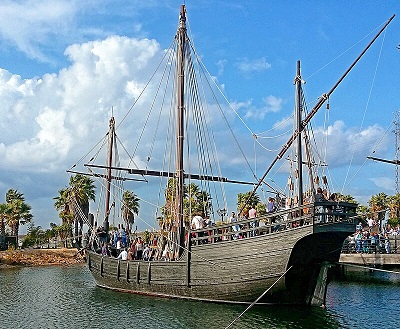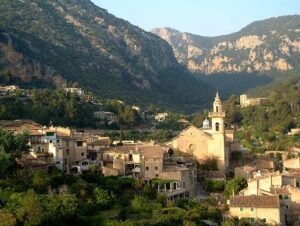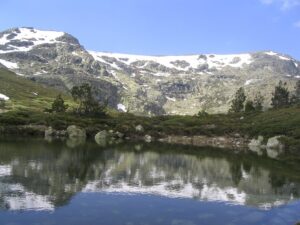Huelva Guide
10 of the best things to see in Huelva
Follow in the footsteps of Christopher Columbus on your own journey of discovery. Many British tourists may not even have heard of Huelva and it is often over looked in favour of its more famous neighbours like Seville or Cadiz, but Huelva city and its surrounding province have plenty to explore in the way of both natural beauty and a rich history. Christopher Columbus first set sail from Huelva and the city’s history and places of interest are closely linked with his journey of discovery.
1. Muelle de las Carabelas (Wharf of the Caravels)

The Muelle de las Carabelas is where you can explore full-scale replicas of Christopher Columbus’s famous ships: the Niña, the Pinta, and the Santa María. These ships were pivotal in the discovery of the New World, and visiting the wharf offers an interactive experience that allows you to step back in time to the era of exploration.
2. La Rábida Monastery
Another historical landmark tied to Christopher Columbus, La Rábida Monastery is where Columbus stayed and planned his voyage before setting sail to the Americas. The Franciscan monastery, founded in the 13th century, is a site of great historical significance. Visitors can explore the beautifully preserved cloisters, chapels, and a museum that showcases artifacts related to Columbus and his journeys.
3. Playa de Matalascañas
If you’re in need of some relaxation, head to Playa de Matalascañas, Huelva’s most popular beach. With its golden sands and clear waters, it’s perfect for a day of sunbathing, swimming, or strolling along the shore. The beach is also home to the Torre de la Higuera, an ancient watchtower partially submerged in the sea, adding a touch of historical intrigue to your beach day.
4. Santuario de Nuestra Señora de la Cinta (Sanctuary of Our Lady of the Ribbon)
This beautiful sanctuary, dedicated to Huelva’s patron saint, is a spiritual and architectural treasure. Perched on a hill with panoramic views of the city, the sanctuary features a blend of Gothic-Mudéjar styles with intricate tiles and serene gardens. It’s a peaceful place to reflect and soak in the local culture.
5. Barrio Reina Victoria
Step into a different era by visiting the Barrio Reina Victoria, also known as Barrio Obrero (Workers’ Quarter). Built in the early 20th century for the British workers of the Rio Tinto mining company, this neighbourhood showcases unique British-style architecture, with quaint houses and charming streets. You may even come across a typical British red telephone box. At times, you could almost be forgiven for thinking you haven’t left home, apart from the difference in the weather!
6. Museo de Huelva (Huelva Museum)
To delve deeper into the region’s rich history, visit the Museo de Huelva. This museum houses an impressive collection of artifacts from prehistoric times to the Roman era, including notable items from the Tartessian culture. The museum also features a fine arts section with works by notable Spanish artists. It’s a fascinating place to learn more about Huelva’s past and cultural heritage.
7. Casa Colón (Columbus House)
Casa Colón is a striking building that serves as a cultural centre and venue for various events, including the annual Latin American Cinema Festival. Originally a luxurious hotel, Casa Colón reflects Huelva’s connection to the New World and its influence on trade and culture. The building itself is an architectural gem, combining different styles and offering insight into the city’s historical connections.
8. Estadio Nuevo Colombino
For sports enthusiasts, catching a game at the Estadio Nuevo Colombino, home of Recreativo de Huelva, Spain’s oldest football club, is a thrilling experience. The stadium not only hosts exciting football matches but also offers a glimpse into the local passion for the sport. Attending a game here allows you to immerse yourself in the vibrant local culture and cheer along with passionate fans.
9. Marismas del Odiel (Odiel Marshes)
A haven for nature enthusiasts, the Marismas del Odiel is a biosphere reserve that offers stunning landscapes and a chance to see flamingos, spoonbills, and other migratory birds. The marshes are an important wetland ecosystem, and several guided tours are available to explore its rich biodiversity. It’s a perfect destination for those interested in ecology and wildlife.
10. Ruta del Vino del Condado de Huelva (Wine Route of Huelva County)
No visit to Huelva would be complete without sampling its local wines. The Wine Route of Huelva County offers a journey through picturesque vineyards and wineries, where you can taste the unique flavours of the region’s wines, including the famous Vino Naranja (orange wine). Along the route, you’ll also find charming villages, traditional Andalusian cuisine, and warm hospitality, making it an unforgettable experience.
Related articles

Are British tourists still welcome in Mallorca?
Following anti-tourist demonstrations, you could be wondering if tourists are still welcome in Mallorca? The simple answer is yes, but

Guadarrama: a local view
Guadarrama makes the perfect day trip from the hustle and bustle of Madrid and is well worth a visit.

Hidden Corners of A Coruña: Lesser-Known Things to See and Do
The iconic landmarks of A Coruña may be its Roman lighthouse, sweeping seafront promenade, and bustling plazas, but beyond the

Gastronomy in A Coruña: where tradition meets Michelin stars
A Coruña is increasingly recognized as one of Spain’s great gastronomic capitals. With one of the highest concentrations of Michelin-starred
